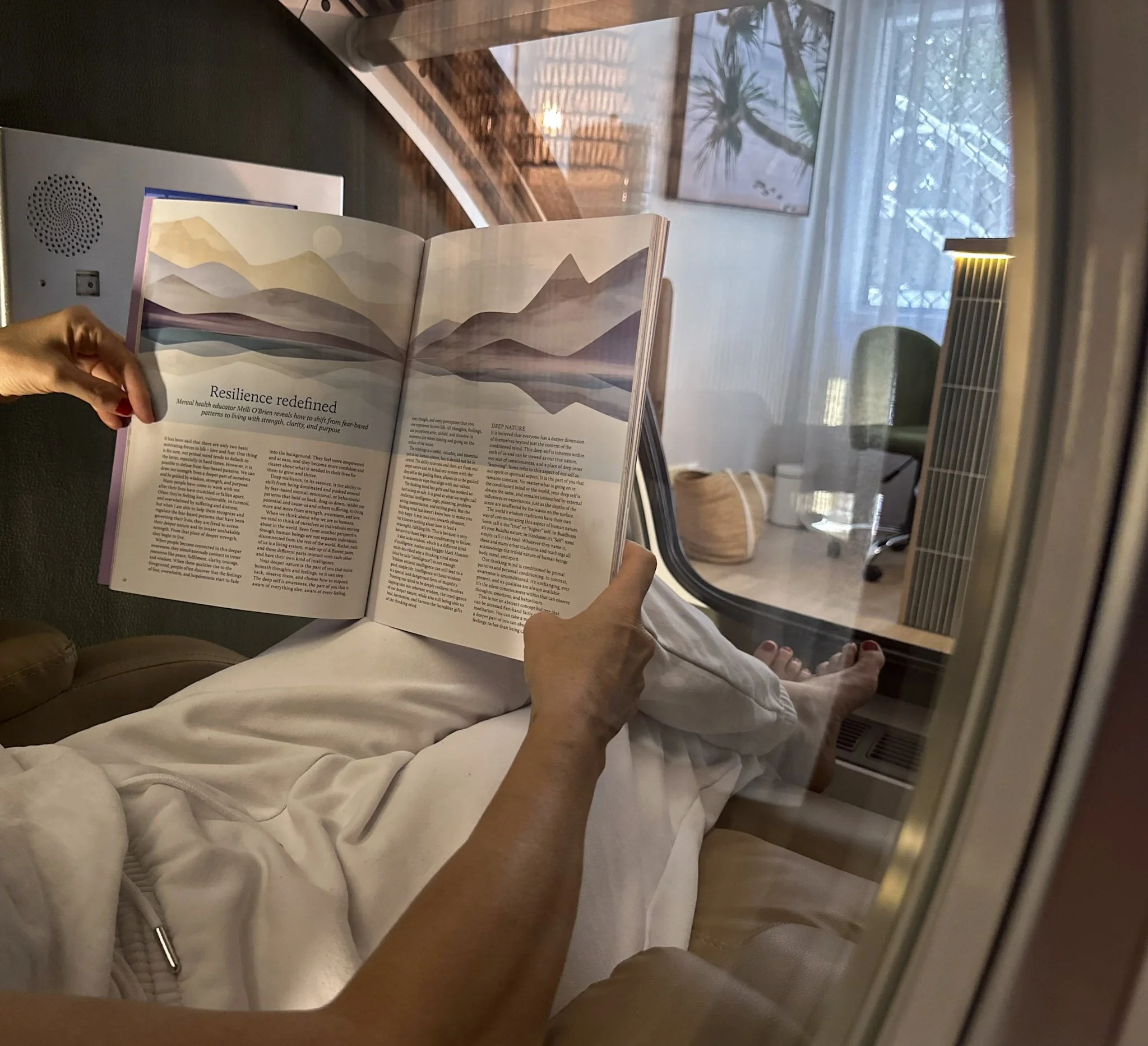What conditions can Hyperbaric Oxygen be used for?
-
What it involves:
The recovery phase following surgery is when your body begins to repair tissues and return to normal function. It’s a crucial time for healing and restoring strength.How hyperbaric oxygen therapy supports recovery:
HBOT delivers concentrated oxygen to the body, which enhances tissue regeneration, reduces swelling, and accelerates the healing process.Ideal for recovery after:
Cosmetic procedures
Orthopaedic surgeries (e.g. joint replacements)
-
What it involves:
Whether you're an athlete or simply active, peak performance and effective recovery rely on your body’s ability to repair, regenerate, and stay energised.How HBOT supports recovery:
HBOT naturally enhances the body’s oxygen uptake—similar in effect to boosting endurance, but without the risks associated with artificial methods. It helps reduce inflammation, speeds up muscle repair, and supports faster recovery after intense physical exertion.Ideal for:
Athletic performance and recovery
Post-training fatigue or muscle soreness
Injury prevention and soft tissue repair
Optimising energy and endurance levels
-
What it involves:
Your nervous system—including your brain, spinal cord, and peripheral nerves—controls everything from movement and mood to memory and healing. When it’s under stress or affected by injury or inflammation, neurological function can become impaired.How hyperbaric oxygen therapy supports it:
HBOT enhances oxygen delivery to brain and nerve tissues, supporting clarity, mood balance, and neural repair. It can help reduce inflammation in the brain, promote neuroplasticity (the brain's ability to adapt and heal), and assist with recovery from neurological strain or injury.How it helps:
Brain fog and mental fatigue
Stress-related nervous system dysregulation
Concussion or head trauma recovery support
Supporting focus, clarity, and cognitive function
Can benefit neurological conditions, including:
Autism
Multiple Sclerosis
Motor Neurons Disease
Parkinson’s Disease
Alzheimer’s Disease
-
Immune Support
What it involves:
Your immune system is your body’s frontline defense—identifying, responding to, and neutralising pathogens, inflammation, and cellular stress. A strong immune response relies on optimal oxygenation, circulation, and cellular function.How hyperbaric oxygen therapy supports immune health:
HBOT increases the partial pressure of oxygen in blood plasma, creating a hyperoxic environment that supports leukocyte (white blood cell) activity, enhances mitochondrial efficiency, and modulates the inflammatory response. This promotes tissue repair, supports detoxification, and helps regulate immune balance at the cellular level.Ideal for:
Strengthening immune resilience
Chronic inflammation or immune dysregulation
Post-viral recovery support
Supporting tissue healing and cellular regeneration
-
Aging & Longevity
What it involves:
Aging is a natural biological process marked by slower cellular repair, collagen loss, mitochondrial decline, and increased inflammation. Longevity isn’t just about living longer—it’s about maintaining vibrancy, resilience, and health as we age.How hyperbaric oxygen therapy supports healthy aging:
HBOT delivers pure oxygen under pressure, creating a temporary rise in reactive oxygen species (ROS)—a natural part of the process. While this may sound counterintuitive, it actually activates the body’s own antioxidant defenses, boosting resilience and cellular repair. This hormetic (adaptive) response helps reduce long-term oxidative stress and inflammation.Research also suggests HBOT may stimulate stem cell release, support collagen production, and even lengthen telomeres—the protective DNA caps linked to aging and cellular longevity.
Ideal for:
Enhancing skin elasticity and collagen
Supporting cellular repair and vitality
Promoting healthy telomere maintenance
Reducing inflammation and oxidative stress over time
Boosting energy and age-defying resilience
-
What it involves:
A Traumatic Brain Injury (TBI) results from an external force—such as a fall, blow, or accident—that disrupts normal brain function. TBIs range from mild (like concussions) to severe, and may lead to lasting issues with memory, focus, mood, coordination, and fatigue due to inflammation, neuronal damage, and impaired oxygen delivery in the brain.How hyperbaric oxygen therapy supports brain recovery:
HBOT increases the amount of oxygen dissolved in the blood plasma, allowing more oxygen to reach injured brain tissue—even in areas with compromised circulation. This enhanced oxygenation helps reduce neuroinflammation, support neuroplasticity (the brain’s ability to heal and rewire), and stimulate mitochondrial repair in damaged cells. It may also improve cognitive clarity, focus, and emotional regulation in individuals recovering from TBI.Ideal for:
Concussion and post-concussion syndrome
Stroke recovery support
Mild to moderate traumatic brain injuries
Cognitive fatigue, brain fog, and emotional dysregulation after injury
-
What it involves:
Jet lag occurs when your circadian rhythm (the body’s internal clock) becomes disrupted due to rapid travel across time zones. This can result in fatigue, insomnia, brain fog, mood changes, and digestive upset—especially after long-haul flights.How hyperbaric oxygen therapy supports recovery:
HBOT enhances oxygen delivery to the brain and body, helping to rebalance circadian rhythms, reduce travel-related fatigue, and improve cellular energy production. It supports mitochondrial function and reduces oxidative stress caused by air travel, cabin pressure, dehydration, and sleep disruption. This results in faster recovery and a smoother transition to new time zones.Ideal for:
Frequent flyers and business travellers
Fatigue, brain fog, or poor sleep after flights
Rebalancing energy, focus, and mood
Supporting hydration and cellular recovery post-travel
-
What it involves:
Healthy, radiant skin relies on strong circulation, collagen production, and the body’s natural repair processes. Environmental stress, inflammation, and aging can disrupt these systems—leading to dullness, fine lines, or delayed healing.How hyperbaric oxygen therapy supports skin health:
HBOT delivers oxygen-rich plasma to the skin and subcutaneous tissues, promoting fibroblast activity, collagen synthesis, and angiogenesis (the formation of new blood vessels). It supports cellular turnover, reduces oxidative stress, and enhances skin repair from within—naturally promoting a clearer, more youthful complexion.Ideal for:
Post-cosmetic procedure healing
Fine lines, dullness, and skin fatigue
Acne and inflammation-prone skin
Overall glow and rejuvenation from the inside out
-
What it involves:
Post-Traumatic Stress Disorder (PTSD) is a complex condition that can develop after exposure to trauma, affecting emotional regulation, memory, sleep, and nervous system function. Anxiety involves persistent feelings of fear, worry, or unease—often accompanied by physical symptoms like restlessness, muscle tension, and racing thoughts.Both conditions are linked to dysregulation in the limbic system, autonomic nervous system, and hypoxia (low oxygen availability) in certain brain regions—especially the prefrontal cortex and amygdala.
How hyperbaric oxygen therapy supports emotional healing:
HBOT increases oxygen delivery to oxygen-deprived areas of the brain, reduces neuroinflammation, and supports neuroplasticity—the brain’s ability to rewire and regulate itself. It may help calm overactive stress responses, improve mood regulation, and restore nervous system balance. Studies have shown promising results in HBOT’s ability to support individuals with PTSD and mood-related disorders.Ideal for:
PTSD symptom management and nervous system regulation
Anxiety and emotional overwhelm
Supporting cognitive clarity and mood balance
Mental burnout and trauma recovery support
-
What it involves:
Cancer can create an oxygen-deprived (hypoxic) environment in tissues, which may contribute to tumour progression and resistance to therapy. Treatments like chemotherapy and radiation, while sometimes necessary, can also cause tissue damage, inflammation, and fatigue—making recovery complex and multifaceted.How hyperbaric oxygen therapy supports recovery:
HBOT delivers 100% oxygen under pressure, increasing oxygen saturation in blood plasma and surrounding tissues—even in areas with compromised blood flow. This oxygen-rich environment counteracts hypoxia, helping restore tissue function, promote angiogenesis (new blood vessel growth), and support immune response. In post-radiation patients, HBOT is well-documented for repairing radiation-induced tissue damage and improving quality of life during and after treatment.HBOT may help create a less favourable environment for cancer cell survival by reducing anaerobic conditions—supporting the body's natural healing systems.
Ideal for:
Healing radiation tissue injury (e.g. osteoradionecrosis, soft tissue necrosis)
Post-surgical recovery and wound healing
Supporting vitality and energy post-treatment
Assisting oxygen delivery in compromised tissues
-
What it involves:
Wound healing is a complex biological process involving tissue repair, immune activation, and cellular regeneration. When wounds become chronic or slow to heal—due to poor circulation, inflammation, diabetes, or infection—healing can stall or become compromised.How hyperbaric oxygen therapy supports wound repair:
HBOT saturates the blood plasma with oxygen, allowing it to reach damaged or poorly perfused tissue that red blood cells can’t easily access. This high-oxygen environment supports fibroblast activation, collagen synthesis, angiogenesis, and immune cell function—all of which are essential for wound closure and regeneration.HBOT has been widely used to support non-healing wounds, including diabetic ulcers, surgical wounds, and soft tissue injuries—especially where oxygen delivery is impaired.
Ideal for:
Chronic wounds (e.g. diabetic foot ulcers, pressure sores)
Post-surgical incisions or graft sites
Soft tissue injuries and inflammation
Wounds with delayed healing or risk of infection
Burns
-
What it involves:
Dental and oral surgical procedures—such as extractions, implants, or bone grafts—rely heavily on proper healing, blood flow, and infection prevention. In certain cases, especially in patients with radiation exposure or chronic conditions, healing can be impaired.How hyperbaric oxygen therapy supports oral health:
HBOT enhances oxygen delivery to hard-to-reach areas like the jawbone and gum tissue, where blood flow may be limited. It promotes angiogenesis, bone regeneration, and collagen formation, while also reducing inflammation and fighting anaerobic bacterial infections. It is clinically recognized in supporting osteoradionecrosis of the jaw (a complication following head and neck radiation), and may improve outcomes after oral surgeries.Ideal for:
Osteoradionecrosis (ORN) prevention and treatment
Dental implant integration support
Healing after extractions or jaw surgery
Periodontal inflammation or infections
Bone graft healing and oral tissue regeneration
Osteomyelitis
-
What it involves:
Long COVID—also known as post-viral or post-acute sequelae of COVID-19—refers to persistent symptoms that linger for weeks or months after the initial infection. Common symptoms include fatigue, brain fog, shortness of breath, muscle aches, poor sleep, and nervous system dysregulation. Many of these issues are linked to lingering inflammation, microvascular damage, and impaired oxygen delivery to tissues.How hyperbaric oxygen therapy supports recovery:
HBOT delivers oxygen at high pressure, saturating the body’s tissues—including those affected by inflammation or reduced circulation. It supports cellular repair, improves microvascular function, and may help restore oxygen flow to the brain and lungs. Clinical studies show HBOT may reduce symptoms like fatigue, brain fog, and breathlessness in individuals with Long COVID by improving mitochondrial function, reducing inflammation, and promoting tissue healing.Ideal for:
Post-COVID fatigue and low energy
Brain fog and cognitive sluggishness
Breathlessness and reduced stamina
Inflammation and nervous system imbalance
-
What it involves:
Chronic illnesses—including autoimmune conditions and post-infectious syndromes like Lyme disease or Long COVID—often involve persistent inflammation, immune system dysregulation, and cellular oxidative stress. These imbalances can lead to fatigue, pain, brain fog, and slowed recovery.How hyperbaric oxygen therapy supports recovery:
HBOT delivers oxygen at levels that temporarily increase oxidative activity—but this triggers the body’s own antioxidant response, helping to rebalance oxidative stress over time. It also improves oxygen delivery to inflamed or oxygen-deprived tissues, promoting immune modulation, cellular repair, and anti-inflammatory effects.Ideal for:
Autoimmune conditions (e.g. lupus, rheumatoid arthritis, Hashimoto’s)
Chronic infections and post-viral syndromes (e.g. Lyme, Long COVID)
Fatigue, pain, or brain fog associated with inflammation
Supporting cellular healing and immune system balance
“Thrive O₂ Hyperbaric Wellness provides supportive wellness services and does not offer medical diagnosis or treatment. Individuals with chronic, complex, or debilitating conditions are encouraged to consult their healthcare provider before beginning any new therapy. HBOT is best used as part of a collaborative care plan alongside a qualified medical professional.”
“When you give the body what it needs, it remembers how to heal.”
— Thrive O2
Contact us
At Thrive O₂, your wellbeing is our priority. Whether you have questions about our therapies or you're ready to schedule a session, we’re here to help. Reach out via phone, email, or the form below — and step into a space designed to help you breathe deeper, feel lighter, and thrive.


